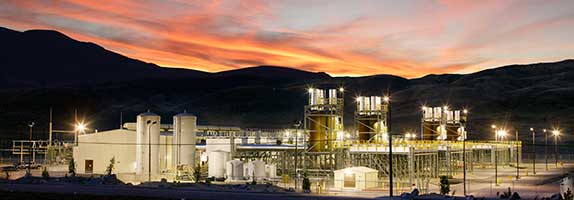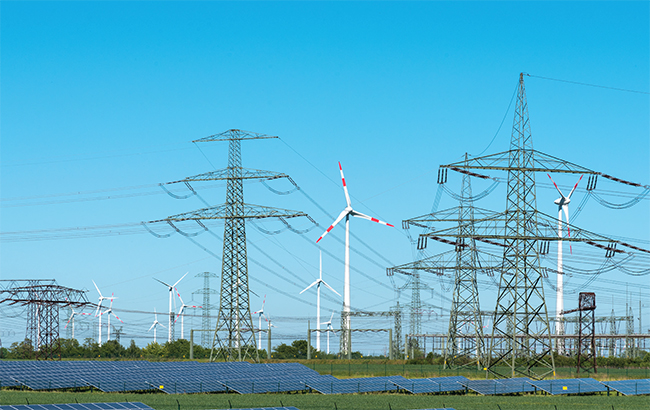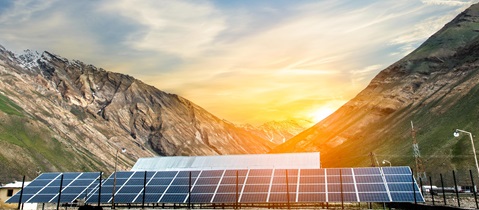

About Marine
Energizing India
Wärtsilä power plants are the ideal solution for decentralized power production and an attractive alternative to the conventional model of centralized power plants.
Wärtsilä’s solutions are available for large plants of 500 + MW capacity. Our gas based power plants are highly flexible and offer the following benefits:
Our power plants can be used for base-load applications or for peak-load needs or to complement wind energy. Our engines can handle liquid fuels such as HFO/LSHS, LFO, LBF or natural gas. Versatile dual-fuel engines can switch between liquid fuel and gas, on line. The CCHP solutions have a very low CO2 footprint, and merit status of ‘deemed renewable energy’.
We provide complete EPC solutions and lifecycle O&M support.
Wärtsilä has been involved with the Indian market for over 25 years, and has an installed base that exceeds 3500 MW, with a large service organisation to provide lifecycle support to customers. Many of the engines have clocked over 1,00,000 hours of operation. The 48MW power plant at Mangalore Chemicals & Fertilisers Ltd has completed 25 years of continuous generation.
For India to take a rightful place in the group of developed nations, electrical energy availability to each section of the population in stable and adequate quantity is a must. Energy demand fluctuates during the course of 24 hours in a day, during passage of different seasons and also sees substantial unpredictability over the years based on climatic condition, political and social expressions and many other factors specific to that year. Introduction of renewable power feed such as wind & solar etc. though extremely desirable from environment & sustainability point of view, adds more unpredictability to the supply-demand situation in the grid.
Wärtsilä leads the transition towards a 100% renewable energy future. We help our customers in decarbonisation by developing market-leading technologies. These cover future-fuel enabled balancing power plants, hybrid solutions, energy storage and optimisation technology, including the GEMS energy management platform. Wärtsilä Energy’s lifecycle services are designed to increase efficiency, promote reliability and guarantee operational performance.
Our track record comprises 74 GW of power plant capacity and more than 80 energy storage systems delivered to 180 countries around the world.

The electricity landscape in India is evolving rapidly. The government is committed to increasing the share of non-fossil fuels in the electricity mix to 50 percent by 2030. Increasing the share of renewables in the electricity mix will make the power system more sustainable. However, the efficient integration of renewables in the grid can be rather cumbersome without suitable balancing resources.
Managing India's power system is becoming increasingly complex as it's resource mix evolves to include more weather dependent, decentralised, and variable renewable energy sources. In order to deal with such complexity, the system operator will need more flexibility to serve load while maintaining grid reliability.
Considering the changing system needs, Wartsila commissioned KPMG to carry out an Ancillary Services Market Study to understand the market structure in India. How can we provide appropriate price signals to reflect both operational and resource requirements while encouraging efficient investment and retirement decisions?
ii.jpg?sfvrsn=40f58544_6)

Wärtsilä, in collaboration with the Lappeenranta-Lahti University of Technology (LUT), has carried out a modelling study to explore the feasibility of a net-zero power system across India by 2050. The findings of the study show that India can undertake a cost-optimal shift to 100% renewable energy (RES) and avoid locking in a highly polluting, more expensive and less effective transition.
Mumbai, November 23rd, 2021:
The technology group Wärtsilä and KPMG, a leading consultancy firm, recently unveiled a joint study on the current status of the ancillary services market in India along with recommendations. The study demonstrates that supply-side flexibility is needed at the pan India level for an efficient and cost-effective integration of 450 GW of renewables by 2030. However, a step change is required in the way ancillary services markets are procured and markets are structured in India. Moreover, the pricing of ancillary services should also encourage investments in the desired flexible generation technologies. The study suggests that India’s power grid could benefit immensely by jointly procuring the energy and ancillary services (co-optimized) in the same day-ahead and real time market, while tightening resource adequacy rules.
Managing India's power system is becoming increasingly complex as its resource mix includes more weather-dependent and decentralized energy sources. To deal with such complexity, the system operator needs greater operational flexibility in order to reliably serve the load, which means an increased need for ancillary services to keep the grid stable. Modeling some renewable-rich states, such as Gujarat, Tamil Nadu, and Rajasthan, validates the need for additional operational flexibility at the state level. The state-level analysis reveals that the addition of 1000 MW of thermal balancing power plants, together with 500 MW 4-hour of battery storage in the electricity mix in each state, even in 2021, optimizes the existing power plants' dispatch for better efficiency, lower O&M costs, and reduced renewable curtailment. This results in cost savings of at-least 3.2 – 7 cr per day for each modeled state. Thermal balancing plants have the capability to achieve 100 percent loading in less than 5 minutes.
In India, ancillary services have historically been delivered by identified thermal power plants. However, some of the recent changes proposed by the regulatory commission indicate further liberalizing of this market segment by encouraging other participants to offer ancillary services. India’s policymakers, regulators, and industry experts are convinced that energy and ancillary services markets require reforms in response to the changing resource mix and load profiles.
Commenting on the study, Mr. Sandeep Sarin, Head - Market Development and Policy, Wärtsilä India, said, “Given how our power market is structured today, we need to ensure that our grid is equipped to integrate 450 GW of renewables by 2030. We need more resources such as thermal balancing power plants, as well as battery storage to manage system imbalances caused by the intermittency of renewables, and to support the grid during periods of renewables drought. Apart from Solar and Wind, the Government should focus on changing the way our power market is structured to offer enough incentives for investments in flexible technologies. The joint study Electricity market design for efficient procurement of ancillary services in India to address changing system needs by Wartsila and KPMG makes a case for power market reforms in India using power system simulation models.”
Dr. Puneet Chitkara, Executive Director ITA-Lighthouse, KPMG said “COP 26 commitments can be met if India consistently adds at least 35 GW of RE capacity annually, duly supported by at least 2500 MWhr of battery storage systems. As RE, especially solar, penetration increases, the role of flexible thermal balancers becomes critical – these plants will need to be completely shut down at least two times a day. With such a plan, the need for new coal fired capacities beyond those that have already been planned, is completely obviated. Even today, if RE states contract BESS and thermal balancing resources, the cost of reliably operating the state power system, without inviting high DSM charges, can reduce by up to INR 7 Crore / day. Curtailment of RE resources also reduces considerably. The opportunity value of storage and gas based ancillary reserves is huge. When MBED is implemented, these technologies will attract even better revenue streams. The steps taken by MoP and CERC are very timely and their scope can be further expanded to help the Indian power system to transition from a coal-centric to a RE-centric power system.”
The study’s key findings include:
· The current market’s design and structure need to be further enhanced to manage imbalances efficiently at the state boundary. Efficient market design where energy and ancillary services are co-optimized will encourage investments in flexible resources for imbalance management.
· Even with large balancing areas facilitated by the MBED mechanism, investment in flexible assets is required to achieve reliable grids.
· The study demonstrates that India’s power system would not require any new coal fired power plants to be commissioned beyond the planned ones, to meet a 340 GW peak demand:
a) India’s power grid could immensely benefit from using both internal combustion gas engines (ICE) and battery storage for meeting the flexibility requirements. The results indicate that by 2030 India would need 38 GW of four-hour battery storage and 9 GW of ICE (thermal balancing power plants) for the cost-efficient and reliable integration of 450 GW of renewables.
b) More than 35 GW of wind and solar capacities should be consistently added annually between now and 2030.
· Higher flexibility reduces the cost of power in the system by enabling the full dispatch of low-cost generators, while at the same time ensuring grid resilience.
· Resource adequacy needs a clear definition, and state utilities need to have a resource adequacy plan. Capacity payments will be key for attracting the right resources. Centralized or regional procurement helps lower costs.
· Co-optimization of the energy and ancillary services market is more efficient than separate markets for energy and ancillary services.
Media contact for more information on this release:
Neelayam Sorte
Manager, Marketing & Communications
Wärtsilä Energy
Mob: +91 7045476881
neelayam.sorte@wartsila.com
Wärtsilä Energy in brief
Wärtsilä Energy leads the transition towards a 100% renewable energy future. We help our customers unlock the value of the energy transition by optimising their energy systems and future-proofing their assets. Our offering comprises flexible power plants, energy management systems, and storage, as well as lifecycle services that ensure increased efficiency and guaranteed performance. Wärtsilä has delivered 72 GW of power plant capacity in 180 countries around the world.
https://www.wartsila.com/energy
Wärtsilä in brief
Wärtsilä is a global leader in smart technologies and complete lifecycle solutions for the marine and energy markets. By emphasising sustainable innovation, total efficiency and data analytics, Wärtsilä maximizes the environmental and economic performance of the vessels and power plants of its customers. In 2020, Wärtsilä's net sales totaled EUR 4.6 billion with approximately 18,000 employees. The company has operations in over 200 locations in more than 70 countries around the world. Wärtsilä is listed on Nasdaq Helsinki.
Please fill in the form, we aim to respond within 1-2 business days depending on the enquiry. For an existing installation, provide all necessary details to identify the installation and the equipment. Fields indicated with an asterisk (*) are required.